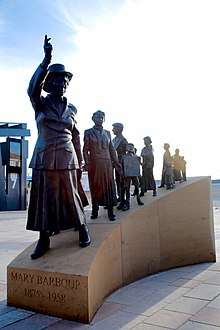Mary Burns Laird
Mary Burns Laird was a founding member and first President of the Glasgow Women's Housing Association, a President of the Partick Branch of the Women's Labour League, associated with the Red Clydeside movement, and supported the Glasgow Rent Strikes of 1915 alongside figures including Mary Barbour, Agnes Dollan, Mary Jeff and Helen Crawfurd.[1][2]
Biography
Mary Burns Laird was born in 1864 to Margaret Walker and Hugh Burns, who were both born in Ireland. In 1884, she married John Laird, who was a ship builder's clerk. The wedding took place in Kinning Park.[3] She was a sewing machinist. Her own father, Hugh was a Deputy Harbourmaster at the time of the marriage. She and John had three children, Annie, Mary and Robert[4] and the family stayed on Blantyre Road, Anderston.[4]
Laird was a prominent Labour activist and patron of the Women's Labour League. In 1913, as a member of the Women's Labour League, she gave a prepared sattement and then was a witness to the Royal Commission on the Housing of the industrial population of Scotland Rual and Urban.[5]
In 1914, at the age of 50, became one of the founders and first President of the Glasgow Women's Housing Association.[1][6]

The Glasgow Women's Housing Association was formed on the eve of the First World War in 1914 with support from the Women's Labour League and the Housing Committee of the Glasgow Labour Party, although the organisation was non-political in its membership and commitments.[1] The organisation became a driving force in supporting the 1915 rent strike, and its formation has been described as the major 'pre-war organizational effort' in support of the strikes.[6] In 1915 the Glasgow Women's Housing Association organised a number of meetings in Morris Hall on Shaw Street in Govan to protest rent increases across Glasgow. The first of these meetings, on 16 February, was chaired by Laird and addressed by John S. Taylor, Patrick Dollan and Harry Hopkins.[1] Mary also played a prominent part in another meeting which took place in St Mungo's Halls). In her role as Chair of the Glasgow Women's Housing Association, Mary criticised tenement housing, stating that they were a challenge for housewives, advocating instead the establishment of "cottage homes".[7]
After her involvement in the 1915 Glasgow Rent Strikes, Laird became increasingly involved with the Labour Party and wider social activism. In 1915, the radical publication Forward urged that Laird be adopted as a municipal candidate for the Labour Party as a way of linking housing policy with a direct appeal to women voters.[8] In November 1916, as president of the Partick Branch of the Women's Labour League she presided over a meeting protesting the high prices of food, the cause of which she stated was "profiteering organisations".[9] On May Day 1917, Laird spoke alongside Mary Barbour, Agnes Dollan and Mrs. Ferguson at a rally at Glasgow Green attended by 70,000 people.[2][10] In April 1919, Laird was elected for Labour in School Board elections.[8] As member for Hillhead and Partick, she served on a number of committees responsible for children's welfare.[11]
In 1922 Mary became Treasurer of the Scottish Labour Housing Association.[11] She stood for election to the town council for Partick East in 1924, losing to the moderate candidate, Donald Fletcher[12] then in 1926 she became a member of the Glasgow Trades Council.[11]
References
- Melling, Joseph (1983). Rent strikes : peoples' struggle for housing in West Scotland, 1890-1916 (1. publ. ed.). Edinburgh: Polygon Books. ISBN 0904-919-72-2.
- ed. by Breitenbach, Esther (1992). Out of bounds : women in Scottish society, 1800-1945. Edinburgh: Edinburgh Univ. Press. ISBN 0-7486-0372-7.CS1 maint: extra text: authors list (link)
- Statutory Register of Marriages. National Records of Scotland.
- Census Returns. National Records of Scotland.
- "Royal Commission on the housing of the industrial population of Scotland Rural and Urban Volume II". 1913. p. 390.
- Castells, Manuel (1983). The city and the grassroots : a cross-cultural theory of urban social movements. London: E. Arnold. ISBN 0-7131-6370-4.
- "The Housing Question: Labour Conference in Glasgow". Glasgow Herald. 5 January 1915.
- Smyth, J. J. (2000). Labour in Glasgow, 1896 - 1936 : socialism, suffrage, sectarianism. East Linton, Scotland: Tuckwell Press. ISBN 1-86232-137-X.
- "Protest Against High Food Prices". The Evening Telegraph and Post. 14 November 1916.
- Duncan, Robert (2015). Objectors and Resisters: opposition to conscription and war in Scotland 1914 - 18. Common Print. pp. 136, 137. ISBN 9780993096518.
- Wright, Valerie (2008). Women’s organisations and feminism in interwar Scotland (PDF) (Doctor of Philosophy thesis). University of Glasgow.
- "The Results". Glasgow Herald. 5 November 1924.
- Statutory Death Records. National Records of Scotland.